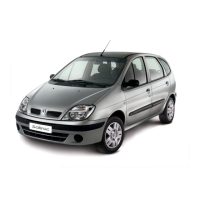QXBIUDB*T[G3DJH
MEGANE SCENIC MONOSPACE NU 679-3
C:\Documentum\Checkout\nu679-3_eng_T1.WIN 25/9/2002 11:11
-page32
1.26
CHILD SAFETY
In all countries there are regulations
governing the use of restraint
systems for children and babies.
In Europe, children under 12 years
of age, less than 1.50 m tall and
weighing less than 36 kg
(1)
must be
restrained with an approved
restraint adapted to the child's
weight and height.
The driver is responsible for
ensuring that this equipment is
used correctly.
Child restraints for which type
approval was obtained after January
1992 offer a level of safety much
greater than for restraints with type
approval before that date.
We therefore advise you to select an
approved child restraint that
complies with European regulation
ECE 44.
Restraints that comply with this
legislation must be marked with an
orange label bearing the letter E
followed by a number (which
represents the country where it is an
approved type) and the year in
which the approval was granted.
(1) Always comply with the laws of the
country in which you are travelling.
They may be different to the
guidelines in this handbook.
Remember that a impact at 30 mph
(50 km/h) is the same as falling a
distance of 10 metres. Expressed in
other terms, transporting a child
without a restraint is the equivalent
of allowing him or her to play on a
third-floor balcony which does not
have any railings.
Under no circumstances
should babies or children
be allowed to travel sitting
on the knees of another
passenger in the vehicle.
If a head-on collision occurs at
30 mph (50 km/h) a child weighing
30 kg (66 lbs) will be transformed
into a missile equivalent to one
tonne: you will find it impossible
to hold the child, even if you
yourself are wearing a belt.
It is particularly dangerous to put
the belt round your child when he
or she is sitting on your knee.
Never use the same belt for more
than one person at the same time.
In accordance with legislation, the
tables listed on the following pages
enable you to recognise the types of
child seat to be fitted to each seat in
the vehicle.
Before fitting a child seat in an
authorised seat
If the vehicle seat is suitably
equipped, make the following
adjustments:
- move the passenger seat as far
back as possible;
- set the seatback to its fully upright
position;
- raise the headrest to its highest
setting;
- raise the seat squab to its highest
setting.
Refer to the Child safety equipment
booklet available from the
RENAULT Network to choose the
seat suited to your child and
recommended for your vehicle.

